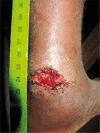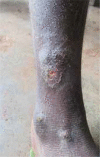Yaws in Pygmy and Bantu children inhabiting the rural zones of Central Africa
- PMID: 36457685
- PMCID: PMC9704468
- DOI: 10.5114/ada.2021.109604
Yaws in Pygmy and Bantu children inhabiting the rural zones of Central Africa
Abstract
Introduction: Yaws, an infectious dermatosis is one of 17 neglected tropical diseases still present in the world despite the efforts aiming at the eradication of the disease undertaken in 2020. It is mainly found in populations living in poor hygiene conditions with a limited access to water and health care facilities. BaAka Pygmies and Bantu people inhabiting the rural areas of the Central African Republic (CAR) are still affected by yaws on a large scale.
Aim: To assess the prevalence of yaws in Central Africa, treatment accessibility, and the need for implementing future health programs.
Material and methods: Primary school BaAka Pygmy and Bantu children from the Dzanga Sangha region (CAR) were assessed in the context of yaws prevalence in years 2019-2020. The diagnosis was based on the clinical picture of the typical skin lesions and their location. Serologic tests were not performed.
Results: Four hundred and ninety-four Pygmies and 235 Bantu children were examined, of whom 38.7% and 43.0%, respectively, presented primary yaws lesions. The mean age of Pygmy and Bantu children with lesions was 9.1 and 9.7 years old, respectively. In both ethnic groups boys predominated. The most common location of yaws lesions were lower legs, ankles, knees and feet.
Conclusions: Yaws, like all other neglected tropical diseases, might become a cosmopolitan skin disease transferred from Africa to Europe and North America by tourists travelling to sub-Saharan destinations in Africa and migrants. The knowledge of tropical skin diseases and ability to make a differential diagnosis might become necessary for each dermatologist in the next 10-20 years.
Keywords: Bantu; Central Africa; Pygmies; Treponema pallidum; yaws.
Copyright: © 2021 Termedia Sp. z o. o.
Conflict of interest statement
The authors declare no conflict of interest.
Figures




Similar articles
-
Yaws in Africa: Past, Present and Future.Diseases. 2025 Jan 14;13(1):14. doi: 10.3390/diseases13010014. Diseases. 2025. PMID: 39851478 Free PMC article. Review.
-
Leprosy - neglected tropical disease in Pygmies inhabiting Central African Republic.Ann Agric Environ Med. 2023 Sep 28;30(3):570-576. doi: 10.26444/aaem/161465. Epub 2023 Mar 7. Ann Agric Environ Med. 2023. PMID: 37772537
-
Prevalence of Asymptomatic Malaria Infections in Seemingly Healthy Children, the Rural Dzanga Sangha Region, Central African Republic.Int J Environ Res Public Health. 2021 Jan 19;18(2):814. doi: 10.3390/ijerph18020814. Int J Environ Res Public Health. 2021. PMID: 33477889 Free PMC article.
-
Intestinal parasitic infections in a population of BaAka Pygmies inhabiting the Congo Basin in the Central African Republic.Ann Agric Environ Med. 2021 Mar 18;28(1):127-130. doi: 10.26444/aaem/131648. Epub 2020 Dec 28. Ann Agric Environ Med. 2021. PMID: 33775078
-
Advances in the Treatment of Yaws.Trop Med Infect Dis. 2018 Aug 29;3(3):92. doi: 10.3390/tropicalmed3030092. Trop Med Infect Dis. 2018. PMID: 30274488 Free PMC article. Review.
Cited by
-
Yaws in Africa: Past, Present and Future.Diseases. 2025 Jan 14;13(1):14. doi: 10.3390/diseases13010014. Diseases. 2025. PMID: 39851478 Free PMC article. Review.
References
-
- World Health Organization . Yaws. Available at: https://www.who.int/news-room/fact-sheets/detail/yaws. Accessed: 6 January 2021.
LinkOut - more resources
Full Text Sources
